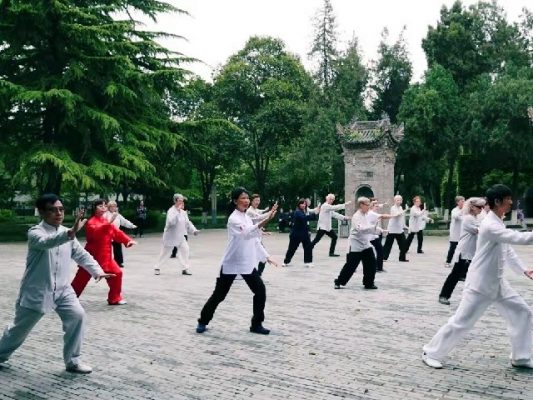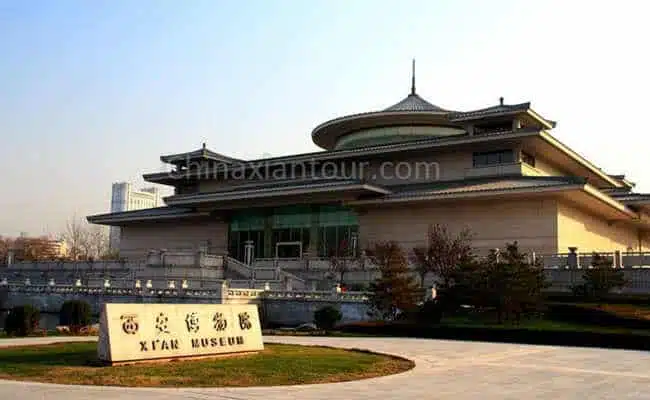Small Wild Goose Pagoda and Xian Museum: Amazing Architecture and Relics
Located in the Jianfu Monastery that lies somewhere at the southeast corner of the crossroads of Youyi and Zhuque south of Xi’an city, the Small Wild Goose Pagoda (or Little Wild Goose Pagoda) is a famous brick pagoda with very compact eaves put up in the Tang Dynasty. As the pagoda is a little smaller in size than the Big Wild Goose Pagoda, it is natural for people to call it the Small Wild Goose Pagoda.
Fast Facts of Small Wild Goose Pagoda
- Type: Historical site, Buddhist site, ancient architecture, museum
- Period: Tang Dynasty
- Opening Hours:15 March – 30 October: 9:00-18:00; November to 14 March: 9:00-17:30 (except on Tuesdays and Spring Festival Eve)
- Tickets: Free entrance fee, RMB 30 for ascending the pagoda
- Time Needed:about 2 hours
- Best Seasons: All seasons
- Highlights: the ancient pagoda, Xi’an Museum, locals do morning exercises in the surrounding garden
- Recommended for: history and culture fans, Buddhists
- Height: the existing pagoda is 43.4 meters high, with 13 stories. The origial pagoda has 15 stories.
- Location: 72 Friendship West Road, Beilin District, Xi’an City, Shaanxi Province; within Jianfu Temple in the southern suburbs of Xi’an
Why Is It Called Small Wild Goose Pagoda?
The pagoda is originally called Jianfusi Temple Pagoda in the Tang Dynasty. The current name is derived from its association with the Giant Wild Goose Pagoda in the Da Ci’en Temple, which is larger and built earlier than the Small Goose Pagoda in Jianfu Temple. The Giant Wild Goose Pagoda was built to store the scriptures and relics brought back by monk Xuan Zang from India, while the Little Wild Goose Pagoda was built to store the scriptures brought back by monk Yi Jing.
History of Small Wild Goose Pagoda
Built in 684, the 1st year of Emperor Ruizong’s reign in the Tang Dynasty the Jianfu Monastery was originally called Xianfu Monastery. Built by Emperor Ruizong for his father Emperor Gaozong in commemoration of the hundred days of his passing away, hence the name “Xianfu Monastery.” however, it was renamed “Jianfu Monastery in 690, the 1st year of Emperor Wu Zetian’s reign when the name of the dynasty was changed from Tang to Zhou.

At that time Jianfu Monastery was a temple of a huge size, striding over two street blocks of Kaihua and Anren and it covered a floor space of over 100, 000 square meters. The temple and pagoda courtyards were the two separate ones. The temple courtyard was located in the northwest was just opposite the south gate and the north fate of the pagoda courtyard was just opposite the south gate of the temple with a street in between. A fire brought down tile temple by the end of the Tang Dynasty. Being moved into the pagoda courtyard Inlet, the two courtyards were combined into one, thereby forming its current size.
The Small Goose Pagoda was built in the period of Emperor Zhongzong’s reign (707-709 A.D.) in the Tang Dynasty and so far it has a history of over 1300 years. The pagoda used to have 15 stories with a height of 45 meters but in 1555. it suffered from the destruction in a severe earthquake. Now it stood about 43 meters high with only 13 stories left. The plane figure of the bottom layer of the pagoda is square with each side measuring 11. 83 meters in length.
The Small Goose Pagoda is a brick-structural tower with compact eaves. With no capital made onto the pillars round the pagoda wall each laver of bricks is made to jut out a little one upon the other, thus forming eaves on each story. And then on the eave is again laid with other layers of bricks with some of them in triangular shape. The pagoda body is gradually reduced from the bottom up to the top, forming a natural conic shape. With eared cabin on each floor the arched gates are opended in the middle of each story to face north and south.
The pagoda has so far undergone more than 70 times of earthquakes. Particularly the one in 1847 ended by leaving a cleft on the pagoda body. However, another earthquake that happened 34 years later brought the cleft sealed up, which was then regarded by people as wrought by nature and the pagoda remained unchanged ever since.
After liberation the pedestal round the pagoda was restored and the arched tunnel through north and south repaired. In addition to the strengthening of the sealed cleft the pagoda eaves, the cornered angles are also made solid and stinger. Inside the pagoda floors are paved with plank-boards with flights of stairs built to link them up and again a lightning rod was installed on top of the pagoda for its safe keeping.
 Small Wild Goose Pagoda
Small Wild Goose Pagoda
What to See and Do in the Scenic Area
Thought not as popular as the Big Wild Goose Pagoda, the Little Wild Goose Pagoda offers a more peaceful experience. What’s more, Xi’an Museum with a variety of artifacts in the scenic area can elevate your historical and cultural experience. If time permits and you want a more in-depth Xi’an exploration, we highly recommend you to add the Small Goose Pagoda to your Xian trip.
Ascend the Pagoda
There are flight of stairs in the pagoda for visitors to go up and down. Visitors can ascend the pagoda to enjoy the vista view of the surrounding area and admire the exquisite Buddhist statues and its architectural features from inside.
Visit Xi’an Museum
Visit the Xi’an Museum next to the pagoda, and see a rich collection of relics, including Buddhist sculptures, paintings, calligraphy, etc.
Experience Local Culture & Life
The Pagoda is in a serene garden where locals haunt to do tai chi, dance, play chess, etc. If you are lucky, you’ll encounter local folk artists practice brush calligraphy on the ground using water.

Enjoy a Shadow Puppet Play
There is a traditional cultural heritage base in the Yan Garden at the northern gate of the scenic area. After visiting the pagoda and the Xi’an Museum, visitors can also make a visit to the garden to admire an enchanting shadow puppetry play which is a folk drama enjoying great popularity in the Guanzhong area (around Xi’an).
Besides the Shadow Puppet Play, you can also expect many other cultural activities, including paper cutting, clay figurines, Chinese calligraphies, etc.
Exhibits in Xi’an Museum
The Small Wild Goose Pagoda is a part of the Xi’an Museum which houses a wealth of historical and cultural artifacts from different periods. It can be an alternative of the crowded Shaanxi History Museum if you want to look into Xi’an’s history with a more serene atmosphere. With its exhibition areas spreading over 5,000 square meters, the museum is home to over 130,000 artifacts of various historical periods, among which, many exhibits can date back to influential dynasties, such as the Zhou, Qin, Han, and Tang.
The exhibition area is divided into three parts, which are basic displays, special exhibitions, and temporary exhibitions. The basic displays part is themed on “Ancient Capital Xi’an”, offering insights into Xian’s urban landscape, societal life and development over 13 dynasties. The special exhibition halls display various Buddhist stone sculptures, ancient paintings, and calligraphy, jade artifacts, etc.

Fairs and Events Held in the Little Wild Goose Pagoda
Since the year 2009, the scenic area holds Spring Festival Fair each year. The highlight of the temple fair here is Praying for Blessing.
The Lantern Exhibition and Culture Exhibition show are also traditional activities of the temple fair. Each year the lantern exhibition set the theme according to the animal sign of that year. For example, 2009 is the year of Cattle so the lantern exhibition of that year set Cattle as the theme. Lanterns in various shaped cattle were on display. 2015 will be the year of Monkey, so we could expect to see various lovely monkeys in the lantern exhibition.
Each year different folk arts of Shaanxi and other parts of China also treat citizens with folk cultural feast.
In the past 6 years, the Temple Fair carried folk culture on stage, the on spot paper cutting allows citizen to know the paper cutting progress and citizens could even learn to cut a paper shade themselves. The well known Huxian County Peasant painters were invited to temple fair to paint on spot. The various color figures made of wheat dough express local people’s good wishes for the coming year. The Fengxiang County clay sculptures, ladle masks and graphic arts displayed special traditional aesthetic perception in west part of Guanzhong Plain. Leather Shadow performance introduced the most ancient opera in Guanzhong Plain to temple fair visitors.
The local snack is the third highlight of the Temple Fair. The various snacks are the favorite of children and young guys. Each one to the Temple Fair will get back home with some bags of snack. If you want to try as many local snacks or find as many Chinese tastes as possible, the temple fair is the best chance during the Spring Festival.
Attractions Nearby
- Giant Wild Goose Pagoda:another famous Buddhist pagoda in Xi’an, with larger size and more crowded.
- The Drum & Bell Tower:two historic landmarks of Xi’an which are used to announce the time in ancient dynasties; offers a panoramic view of Xi’an city center.
- Xian Muslim Quarter:a lively neighborhood with rich cultural and culinary diversity, the Great Mosque of Xian is located in this area.
- Xian Ancient City Wall: the best-preserved city wall in China; allows to walk and cycle atop the wall and look into the ancient and modern faces of Xian.
Tours including Small Wilde Goose Pagoda:
We have more well-designed Xi’an Tours to inspire you.









